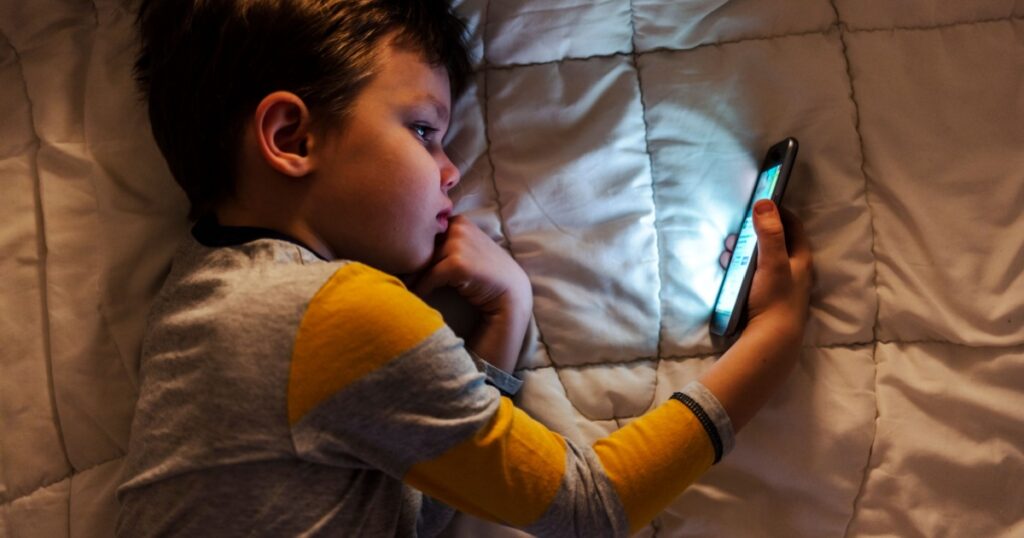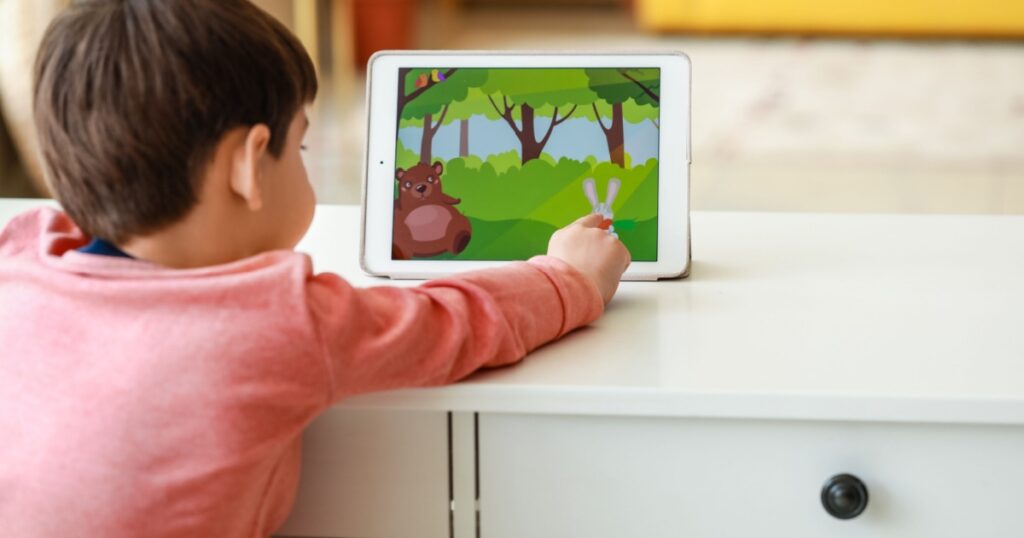Twenty years ago, people didn’t have cells phones. Very few had computers in their homes, and if they did, they either didn’t have internet or they used dial-up, which they couldn’t use if someone needed the phone (which, by the way, was attached to the wall). Hand-held devices weren’t an option for most people, and especially not kids. With the explosion of computers, the internet, and mobile devices, technology has become a huge part of our daily lives, and especially that of our children. Kids today never knew a time where smart phones, iPads, and other mobile devices didn’t exist, and many have never experienced being truly disconnected from the world.
Cell Phones, Tablets, and the Effect of Technology on Children

While there are benefits to technology, the constant use of cell phones and tablets by children can have a detrimental impact on their growth, development, and well-being. It is difficult to deny a child who begs you to have a cell phone of their own like many of the kids in their class do, there are several compelling reasons why you should not allow your kids to have their own mobile device. Technology, especially hand-held that can go with you everywhere, immerses kids into a virtual world that lacks important factors for learning, behavior, and development. Here are 11 Reasons a Child Under 12 Should Not Use a Cell Phone or Tablet:
Read More: Using Social Media is Causing Anxiety, Stress and Depression
1. May Increase Aggression

It’s not easy to control what type of media your children are viewing, especially when they have access to the internet via their phone or tablet wherever they are, with or without you. Exposure to violent media, especially in violent video and online games, has been strongly associated with antisocial tendencies and aggressive thoughts, behaviors, and actions. (1)
2. Potential for Addiction

The fronto-striatal pathway, which is the same neural pathway linked to drug addiction and behavioral disorders, such as gambling, are also associated with certain types of media. Giving your children unlimited access to the internet, social media, and video games via a smart phone or tablet increases your child’s risk of developing these problems themselves, along with an actual addiction to technology. (1)
3. Learning Difficulties

Providing a child with a smart phone or tablet means giving them access to multiple forms of entertainment all at once. This causes them to be more easily distracted and develop an inability to pay attention in class. Along with the attention deficits comes impaired visual memory, imagination, and the ability to work efficiently and effectively or focus in a task. (1)
4. Social Interactions and Anxiety

Our children’s increasing reliance on technology is harming the development of face-to-face social skills. Texting or messaging someone effects how well they learn to express themselves through body language, tone, touch, voice, and facial expression, as well as how to understand those cues from other people.
Kids are also not learning how to deal with their problems and have difficult conversations, often falling back on sending a text or email instead of talking to that person directly. All of this is severely effecting our ability to communicate and have meaningful interactions and relationships with others. (2)
Read More: Parents Use Social Media To Warn Others of Strep in The Sinuses
5. Exposure to Radiation

A child’s head has a two times greater capacity to absorb radiation, and their skull’s bone marrow absorbs ten times the radiation of an adult’s. Though the we don’t yet know all the affects of cell phone radiation, we do know that it increases risk of developing brain tumors and cancer. More studies need to be done on wireless radiation and it’s effects on brain development in children. (3)
6. Increase Risk of Obesity

Several studies have been done proving the correlation between technology use and increased BMI in children and adolescents. This is largely because the more hours kids spend on technology, the more time they spend sedentary instead of in active pursuits. To compound that further, kids who spend the majority of their time using cell phones, tablets, computers, and video games, tend to also snack more while doing so and consuming more calories. (4, 5)
7. Poor Sleep

Children, and especially adolescents, need more sleep each night than adults. Despite requiring 8.5-10 hours each night, most are getting only 7.5-8.5 hours, with many getting even less. The use of cell phones and screens, especially in the few hours leading up to bed time, directly interferes with both sleep quantity and sleep quality. Though scientists are only just beginning to understand the complexity of what happens in our bodies while we sleep, one thing we know for sure is how important sleep is for growing and developing children. To stunt their sleep with technology is to stunt their mental and physical development. (6, 7)
8. Mental Health

There are a number of implications cell phone use has on the mental health of our children. Kids are now exposed to media every day with suggestive messages telling how they should think, feel, act, and look. (8)
Read More: There are Times We Should Wait Before Posting on Social Media, and This is One of Them.
There are a number of factors that cell phones and constant connection has on kids mental health:

- Cyber bullying: Children today are at a much greater risk for cyber bullying, which can lead to depression, anxiety, extreme isolation, and even suicide. (8)
- Sexual pressure: When on their smart phones, kids can be exposed to suggestive images and be pressure to participate in “sexting”, long before they are able to properly understand and process those topics. This pressure can result in anxiety, mental, and emotional distress. (8)
- Facebook Depression: It is well known that people only post their highlight reel on social media, meaning that they typically only share the parts of themselves and their lives that they want you to see. Children don’t necessarily have the awareness to realize this, and therefore compare the mundane parts of their lives with only the exciting parts of others. This leaves them feeling depressed about their life, abilities, or appearance. (8)
- Targeted advertising: Social media and other websites collect information about you based on your profile, what you like, and what you post, and then uses that information to only display ads that you are more likely to be interested in. While many sites, such as Facebook or MySpace, require users to be at least 13 years old in compliance with the law that does not allow collecting information from people under the age of thirteen, many kids still use these sites anyways. They are then exposed to ads and media that they aren’t prepared to deal with or process properly. (8)
9. Decreases Health

Studies now show that media and technology use promotes ill-being among children and youth, independently of lack of exercise and poor nutrition. In general, the more children use and are exposed to technology like cell phones and tablets, the more likely they are to have physical ailments, as well as mental and emotional difficulties. They are more likely to get sick, have physical pains, depression, social and learning disabilities. (9)
10. Poor Posture

As kids spend more and more of their time on phones, computers, and tablets, we see a deterioration in their posture. These children are more likely to adopt the sustained and often awkward postures that are seen in adults with certain musculoskeletal disorders. More studies need to be done on the long-term effects of “cell phone posture” in kids. (10)
11. Eye Strain

Prolonged use of screens can cause digital eye strain in both adults and children, however they way children use technology puts them at particular risk for damaging their vision. While more studies need to be done on the long-term impact of screen time on children’s vision as they get older, symptoms such as headaches, sore eyes, and blurred vision are common. (10, 11)
How to Prevent Your Kids from Becoming Addicted to Screens

As you can see, there are many reasons why kids should not be using cell phones and tablets on a regular basis, with new discoveries being made every day.
Read More: Rejection From Dad Can Lead to Social Anxiety Later In Life
Here are a few tips for how parents can limit screen time for their kids:

- In nice weather (say, summer vacation) no screens, including TV and computer, are allowed to be used for a certain number of hours each day, say from 9 or 10 am until 4 or 5 pm. Encourage your kids to spend that time playing outside with you, their siblings, or their friends.
- Set rules about what age you will allow your child to have a cell phone, for example: Not until they are in high school, or until they have their driver’s license.
- If your child does have a cell phone, you have control over their cell phone plan. Make sure their phone has limited to no data use, so that they can only access the internet when they’re connected to Wifi.
- Have rules about when and where technology can be used in your house. For example, don’t allow phones or tablets at the dinner table, allowing for conversation and quality family time.
- No technology for at least 30 minutes before bedtime (thought preferably longer). Instead, encourage them to spend that time reading or playing.
- Set time limits on TV and internet time, for example: They are only allowed to watch two TV shows or one movie per night, and when using the computer or tablet they are only allowed 30 minutes to an hour. The rest of the time they have to find something else to do.
Read More: 6 Things You Shouldn’t Do In Bed to Get a Good Night’s Sleep
Sources
- https://www.ncbi.nlm.nih.gov/pmc/articles/PMC3170902/
- https://sites.psu.edu/siowfa15/2015/09/16/are-cell-phones-ruining-our-social-skills/
- https://www.tandfonline.com/doi/abs/10.3109/15368378.2011.622827
- https://www.researchgate.net/profile/Rena_Kosti2/publication/6560597_Kosti_RI_Panagiotakos_DB_The_epidemic_of_obesity_in_children_and_adolescents_in_the_world_Cent_Eur_J_Public_Health_14_151-159/links/0046351e985c3a1713000000/Kosti-RI-Panagiotakos-DB-The-epidemic-of-obesity-in-children-and-adolescents-in-the-world-Cent-Eur-J-Public-Health-14-151-159.pdf
- https://www.ncbi.nlm.nih.gov/pmc/articles/PMC1820777/
- https://www.ncbi.nlm.nih.gov/pmc/articles/PMC4089837/
- https://eric.ed.gov/?id=ED527857
- https://pediatrics.aappublications.org/content/pediatrics/127/4/800.full.pdf
- https://www.ncbi.nlm.nih.gov/pmc/articles/PMC4338000/
- https://content.iospress.com/articles/work/wor00236
- https://www.ncbi.nlm.nih.gov/pmc/articles/PMC2776336/

